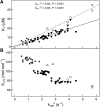Rubisco Catalytic Properties and Temperature Response in Crops
- PMID: 27329223
- PMCID: PMC4972260
- DOI: 10.1104/pp.16.01846
Rubisco Catalytic Properties and Temperature Response in Crops
Abstract
Rubisco catalytic traits and their thermal dependence are two major factors limiting the CO2 assimilation potential of plants. In this study, we present the profile of Rubisco kinetics for 20 crop species at three different temperatures. The results largely confirmed the existence of significant variation in the Rubisco kinetics among species. Although some of the species tended to present Rubisco with higher thermal sensitivity (e.g. Oryza sativa) than others (e.g. Lactuca sativa), interspecific differences depended on the kinetic parameter. Comparing the temperature response of the different kinetic parameters, the Rubisco Km for CO2 presented higher energy of activation than the maximum carboxylation rate and the CO2 compensation point in the absence of mitochondrial respiration. The analysis of the Rubisco large subunit sequence revealed the existence of some sites under adaptive evolution in branches with specific kinetic traits. Because Rubisco kinetics and their temperature dependency were species specific, they largely affected the assimilation potential of Rubisco from the different crops, especially under those conditions (i.e. low CO2 availability at the site of carboxylation and high temperature) inducing Rubisco-limited photosynthesis. As an example, at 25°C, Rubisco from Hordeum vulgare and Glycine max presented, respectively, the highest and lowest potential for CO2 assimilation at both high and low chloroplastic CO2 concentrations. In our opinion, this information is relevant to improve photosynthesis models and should be considered in future attempts to design more efficient Rubiscos.
© 2016 American Society of Plant Biologists. All Rights Reserved.
Figures


Similar articles
-
Rubisco catalytic properties of wild and domesticated relatives provide scope for improving wheat photosynthesis.J Exp Bot. 2016 Mar;67(6):1827-38. doi: 10.1093/jxb/erv574. Epub 2016 Jan 21. J Exp Bot. 2016. PMID: 26798025 Free PMC article.
-
Environmentally driven evolution of Rubisco and improved photosynthesis and growth within the C3 genus Limonium (Plumbaginaceae).New Phytol. 2014 Aug;203(3):989-99. doi: 10.1111/nph.12858. Epub 2014 May 23. New Phytol. 2014. PMID: 24861241
-
Potential improvement of photosynthetic CO2 assimilation in crops by exploiting the natural variation in the temperature response of Rubisco catalytic traits.Curr Opin Plant Biol. 2019 Jun;49:60-67. doi: 10.1016/j.pbi.2019.05.002. Epub 2019 Jun 21. Curr Opin Plant Biol. 2019. PMID: 31234057 Review.
-
Rubisco catalytic properties optimized for present and future climatic conditions.Plant Sci. 2014 Sep;226:61-70. doi: 10.1016/j.plantsci.2014.01.008. Epub 2014 Jan 31. Plant Sci. 2014. PMID: 25113451
-
Evolutionary trends in RuBisCO kinetics and their co-evolution with CO2 concentrating mechanisms.Plant J. 2020 Feb;101(4):897-918. doi: 10.1111/tpj.14643. Epub 2020 Jan 2. Plant J. 2020. PMID: 31820505 Review.
Cited by
-
Exogenous melatonin strongly affects dynamic photosynthesis and enhances water-water cycle in tobacco.Front Plant Sci. 2022 Aug 3;13:917784. doi: 10.3389/fpls.2022.917784. eCollection 2022. Front Plant Sci. 2022. PMID: 35991431 Free PMC article.
-
Acclimation of Biochemical and Diffusive Components of Photosynthesis in Rice, Wheat, and Maize to Heat and Water Deficit: Implications for Modeling Photosynthesis.Front Plant Sci. 2016 Nov 22;7:1719. doi: 10.3389/fpls.2016.01719. eCollection 2016. Front Plant Sci. 2016. PMID: 27920782 Free PMC article.
-
Recent advances in understanding and improving photosynthesis.Fac Rev. 2020 Nov 6;9:5. doi: 10.12703/b/9-5. eCollection 2020. Fac Rev. 2020. PMID: 33659937 Free PMC article. Review.
-
Leaf hydraulic vulnerability triggers the decline in stomatal and mesophyll conductance during drought in rice.J Exp Bot. 2018 Jul 18;69(16):4033-4045. doi: 10.1093/jxb/ery188. J Exp Bot. 2018. PMID: 29788146 Free PMC article.
-
Linking photosynthesis and leaf N allocation under future elevated CO2 and climate warming in Eucalyptus globulus.J Exp Bot. 2017 Feb 1;68(5):1157-1167. doi: 10.1093/jxb/erw484. J Exp Bot. 2017. PMID: 28064178 Free PMC article.
References
-
- Badger MR. (1980) Kinetic properties of ribulose 1,5-bisphosphate carboxylase/oxygenase from Anabaena variabilis. Arch Biochem Biophys 201: 247–254 - PubMed
-
- Badger MR, Collatz GJ (1977) Studies on the kinetic mechanism of ribulose-1,5-bisphosphate carboxylase and oxygenase reactions, with particular reference to the effect of temperature on kinetic parameters. Carnegie Inst Wash Year Book 76: 355–361
-
- Balaguer L, Afif D, Dizengremel P, Dreyer E (1996) Specificity factor of ribulose bisphosphate carboxylase/oxygenase of Quercus robur. Plant Physiol Biochem 34: 879–883
Publication types
MeSH terms
Substances
LinkOut - more resources
Full Text Sources
Other Literature Sources
Research Materials

